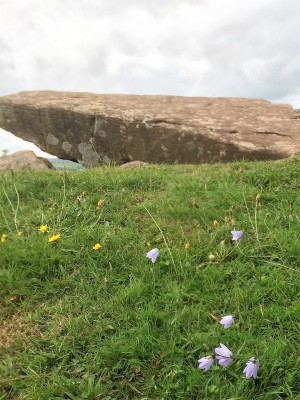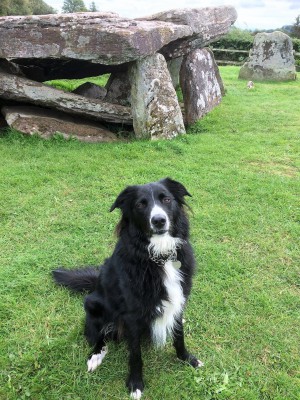1. Saints & Kings in the Golden Valley

Welcome to my new blog!
I have uploaded a few earlier pieces I never got round to posting partly because they are favorites but also because my ramblings have been curtailed this summer due to a broken ankle! So here is the first from August 2017….
Mix a few old tales, some archaeology and a dash of pre-history and you’ve got my attention! A warm and sultry morning in early August seemed like a good day to drive over to Golden Valley in Herefordshire. Here lies Peterchurch, a quiet village near the Welsh border next to the River Dore. My interest in Peterchurch is due to tantalising tales of early saints, lost wells, midsummer wool fairs and a fish with a golden chain around its neck! I want to find one of the remaining wells, St Peter’s, but there is a tempting detour in the way. At an old crossroads of path and track near Dorstone Hill lies Arthur’s Stone, a Neolithic chamber tomb and the oldest man-made structure in Herefordshire.
So we headed west from the Clee Hills in Shropshire towards the Black Mountains of Herefordshire. We crossed the river boundary at Bredwardine, a lovely place for me and my assistant, Dan, to
have a picnic. It was possible to scramble down to the banks of the lovely River Wye where it is shallow and Dan took advantage of the cool water and had a paddle while I watched for kingfishers
but no luck today!
One of my favourite rivers, the Wye always seems decidedly ‘Welsh’ to me, even on its journey through England. It is pretty, quick and gentle and carries much history. Yet like all water, care must be taken: there are rumours here of fairies, wailing ghosts and spectral boats to be avoided at
all cost! So we sat on the banks of the river, and wondered…. what happened to the people who lived in the old castle and the old Guinea Well which folk use to visit for its curing and we pondered why they once grew a cutting here from the Holy Thorn at Glastonbury….

The thorn died a long time ago and the whereabouts of the well is for another day so we returned to the car heading off towards the Golden valley of the River Dore. (Some believe the Golden Valley may have got its name from some early confusion on the part of the Norman invaders who mistook the Welsh word for water ‘dŵr’ for ‘d’or’, French for ‘of gold’). It is a very lovely part in the Marches, a slice of a huge prehistoric landscape of barrows, standing stones and early settlements. As we climbed the views were stunning towards the Clee Hills and behind us, Hay Buff and the Black Mountains of Wales.
It would certainly have been possible to see your neighbours in the settlements across the hills, perhaps even to have communicated across distances in early times but now it’s just me, Dan and a pile of extraordinary stones which have been weaving stories for thousands of years. This was once a busy place! Here Kings and knights met and fought, Arthur ate his dinner (hence an earlier name, Arthur’s table, first recorded in the 18th century) and King Charles gathered his army before retreating at the news of the advancing Parliamentary army. But now all was silent.
Just a few swallows skimming the cornfields, harebells nodding amongst the stones, a few bored looking sheep and a stirring view.

The folklore connected with the site is considerable and the connection with Arthur dates from at least the 13th century. The Herefordshire folklorist, Mrs Leather, writes in 1912 that a local man told her that it got it’s name because ‘owd Artur’ fought another king there and broke his back. They buried the dead king under the stones. Other say that it is the grave of a giant that Arthur fought and buried here. The Victorians said that this was Thor’s stone. There is also a story that the stones are a
lot smaller than we see now – they have shrunk! There use to be an another stone visible, the quoit stone, which lay in the ditch across the lane. Two dents, maybe cup-marks, were said to have been made by
Arthur when he knelt there to pray (or, some say, the marks were made by the giant when he fell). Sadly, many of the stones have been moved over time.
Curiously, Mrs Leather also writes that there is a field close where there is said to be a buried town, engulfed by an earthquake long ago. The church steeple is sometime visible in a pool in the field!
Unfortunately she makes no reference as to where she got this story and I have been unable to locate any similar stories in this area. I would be grateful if anyone does have any local information about
this tale to please get in contact! There is certainly a precedent in early Celtic tales of stories about cities and towns submerged by flood or catastrophe such as Lancarrow in Cornwall, Cantre’r
Gwaelod in Cardigan Bay and, best known, the Breton Story of Ker Ys but these are all from coastal areas so the notion of a similar inland tale intrigues me!
Arthur’s stone was also a meeting place until modern times. Baptist services were held here every Sunday. Mrs Leather, writing in 1912, records that there were ‘merry-makings within living memory at the
Cromlech called Arthur’s stone, and much dancing’. Her informant from Peterchurch remembers ‘great does’ early in the 19th century. It is known that many hill festivals, from scouring hill
horses, to harvest festivals, were held around high summer and at Lammas so this may have been the same at Arthur’s stone.
But what about the early history of this place? Little is known. The site has never been excavated but it is over 5000 years old. Only the inner chamber remains. There has been much damage with many stones taken away for building until quite recently. There are 9 standing upright stones with a massive capstone weighting around 25 tonnes. A false entrance may have been used for ceremonial purposes.
The English Heritage board helpfully tells us that this was not just a tomb but probably used for rituals in which to revere the ancestors and affirm the peoples’ connection to land and place. It says that
this area would have been grazed as summer pasture in pre-history and so used on a seasonal basis, for example, during high summer. This suggests that the more recent traditions of church wakes and dances
and baptist prayers may have been carrying on a Lammas tradition of thousands of years! Incredible! And now, it seems only natural that these stones, after engaging with humanity for all this time, are
slowing returning to their ‘natural state’ as society largely forgets and disengages with the natural world…..so if you are passing, do pop up and say a prayer for the harvest!

Oh, and did we get to Peterchurch? Well, that’s another story…..